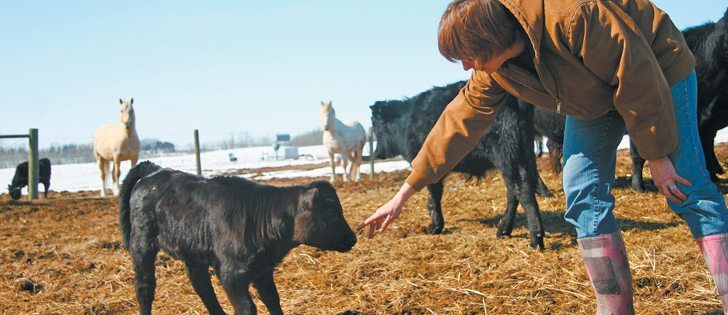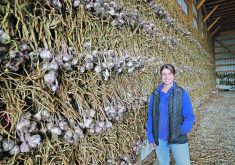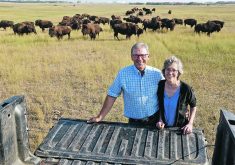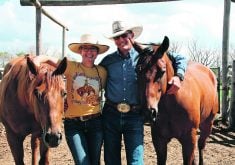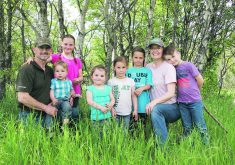Purebred herd | Alberta family finds customers in burgeoning slow food movement
MIRROR, Alta. — Cows and their calves come running toward Mary Ann Stevenson when she walks into the pasture, probing with wet noses to get a friendly scratch.
That pleasant disposition is one of the many things Stevenson and her husband, Les Brunelle, like about Dexters.
The couple has been raising the cattle breed at their central Alberta Applejack Ranch since 2002 but never planned to become the owners of one of Western Canada’s largest purebred herds.
“Initially it was something to keep the grass down. It wasn’t anything we were going into because we both worked off the farm,” Stevenson said.
Read Also

Beef check-off collection system aligns across the country
A single and aligned check-off collection system based on where producers live makes the system equal said Chad Ross, Saskatchewan Cattle Association chair.
Brunelle works in oil patch construction and Stevenson is a nurse and has an occupational health business. They wanted something quiet and low maintenance, and started scouting around when they heard about Dexters, an old breed of small, thrifty Irish cattle. They eventually bought two herds and expanded to 50 cows.
The century old family farm was homesteaded by Stevenson’s grandfather, Thomas Hugh Stevenson. Today, the farm’s heritage breeds include Dexter cattle, Icelandic sheep, Large Black pigs and multi-colored chickens.
“They are your homesteading farm animals,” she said.
The couple became trendy without realizing it as their business evolved into selling grass-fed beef, pork and poultry. They are also members of the slow food movement.
“It kind of evolved, just like the cows,” said Brunelle.
Added Stevenson: “There is a real grassroots, underground movement on the whole ‘where is your food coming from’ thing. Food security is a big deal and we just got caught in it along the way.”
The farm also allows them to know what food they are feeding to their two young children, Aubrey and Raif.
Their provincially inspected meat is processed at a boutique abattoir in Mirror and marketed directly to customers. They work with Dine Alberta, a provincial program that encourages regional cuisine and links farmers with consumers and chefs.
Stevenson also started Applejack Farm School cooking workshops, which have attracted urban chefs who want to get back to basics.
The couple wants to preserve native prairie on the farm and follow a holistic grazing system to keep the ecosystem healthy.
Promotional tools include workshops, farm shows, a website and their location on the Boomtown Trail.
“You have to network, you have to market,” she said. “You can’t just assume somebody is going to drive through your driveway.”
They direct market to cooks who are looking for fresh, locally grown products but have learned they have to know what to do with each cut to reduce waste.
“It is hard to find the chef who has the wherewithal, knowledge and experience to know what to do with that meat,” Brunelle said.
Despite the diversification, the cattle and the beef are the farm’s mainstay.
“Our big seller is not so much the Dexters, but the grass-fed beef,” Stevenson said.
They set aside steers that finish at 16 to 28 months on grass and forage.
They also sell semen, embryos, bulls and both registered and non-registered cows.
The Canadian Dexter Association registers the cattle through Canadian Livestock Records, and the bulls receive genetic testing.
The farm’s breeding plans focus on longevity, good milk and beef production so that it can get the kind of animals it wants or will work well for customers.
“If you want to know what you are buying, registered stock is a good thing,” she said.
“People like coming to a registered breeder because the quality is there and that check is there.”
Guidelines for Dexters
The Dexter is a dual purpose animal with beef and dairy qualities. In judging, both qualities are essential.
- Colours: Whole black, red, and dun. All colours are of equal merit. A small amount of white is allowed but only on the underline, udder area, organs of generation, and the tassel of the tail. White forward of the naval is strongly discouraged.
- Head: Broad between the eyes tapering toward a broad muzzle. Strong jaws with an even bite. Eyes bright and prominent. Nostrils should be wide and distended. Size of the head in proportion to the body.
- Neck: Blending well into the shoulders, thick but not too short. Head should be carried above the spine.
- Horns: Dexters are naturally horned or polled. Removal of the horns should not be penalized in the show ring. Naturally polled animals should not be penalized.
- Body: Breast prominent, chest floor-wide, well sprung ribs, wide across the loin, quarters thick and deep, broad full hips, well-rounded fleshy rump. Straight, level top line with the tail set level with the spine. When viewed from the rear, tail should run straight off the spine. Straight level underline. Good width between both front and back legs.
Source: Canadian Dexter Cattle Association




